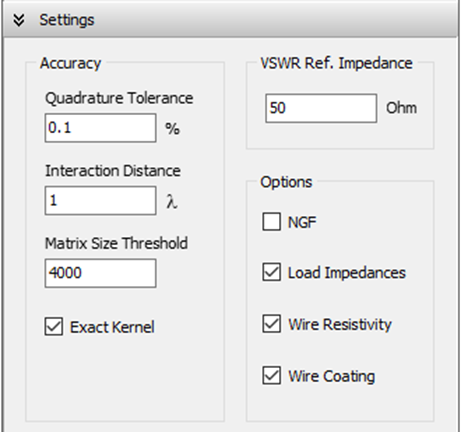Search for answers or browse our Knowledge Base.
Guides | Models | Validation | Blog
The Settings Panel
Go to the Setup tab in the main window and select the Settings panel, Fig. 1.

The accuracy of the integrals involved in the calculations can be set in the Settings panel. The Quadrature Tolerance is the error in the evaluation of interactions between wire segments which are separated by a distance less than the Interaction Distance.
The Interaction Distance is the maximum distance in wavelengths between segments for which an error less than the Quadrature Tolerance is guaranteed in the integrations. The interaction between all wire segments further apart than the Interaction Distance is computed using a third-degree polynomial approximation to the involved integrals, which is more accurate for curved segments than the Hertzian dipole approximation used in the traditional Method of Moments. Therefore, the Interaction Distance could be set to zero for a faster simulation when wire segments are not too close to each other, but results will be less accurate. A convergence test for various values of this parameter is recommended.
For most cases, a quadrature tolerance between 0.1% and 1% and an interaction distance between 0.25 and 1.0 wavelengths will be enough for obtaining accurate results.
In AN-SOF, all calculations are done with double precision. The Matrix Size Threshold allows us to simulate big antenna problems when the size of the structure compromises the available memory space. For instance, by setting the Matrix Size Threshold to 4,000, the set of linear equations associated to the Z-matrix of the antenna system will be computed using single precision for a matrix size bigger than 4,000 x 4,000. This will impact the accuracy of the calculations but will save memory. In practice, the error will be not significant.
The Exact Kernel option allows us to use the exact Kernel for the Electric Field Integral Equation associated to the structure. This option must be chosen when relatively thick wire segments are used to describe the wire structure. If the Exact Kernel option is unchecked, an extended thin-wire approximation will be used for the kernel. If all wire segments are thin enough, then the computation will be a little faster using the extended thin-wire kernel. Refer to The Exact Kernel for further information.
In the Settings panel, the Reference Impedance for VSWR calculations can also be set. A default value of 50 Ohm is set.
Besides, the following options for the type of simulation are available in the Options box:
- If NGF is checked, the Numerical Green’s Function calculation is performed in the simulation, that is, the LU-decomposed matrix of the system is stored in a file in the first simulation. Then, by using the stored information, new simulations are performed faster than the first one. Check this option if you need to change the amplitude values of voltage/current sources frequently.
- If Load Impedances is checked, lumped impedances will be considered in the simulation. With this option all the lumped loads can be disabled or enabled at the same time.
- If Wire Resistivity is checked, the finite resistivity of the wires will be considered in the simulation. Any wire has its own resistivity in [Ohm meter] that can be set when the wire is drawn. This option allows us considering the whole structure as a perfect electric conductor when it is unchecked.
- If Wire Coating is checked, the coating materials of the wires will be considered in the simulation. Any wire has its own coating specified by a dielectric permittivity, magnetic permeability, and thickness, which can be set when the wire is drawn. When this option is unchecked, the wire coating will not be considered in the simulation.
